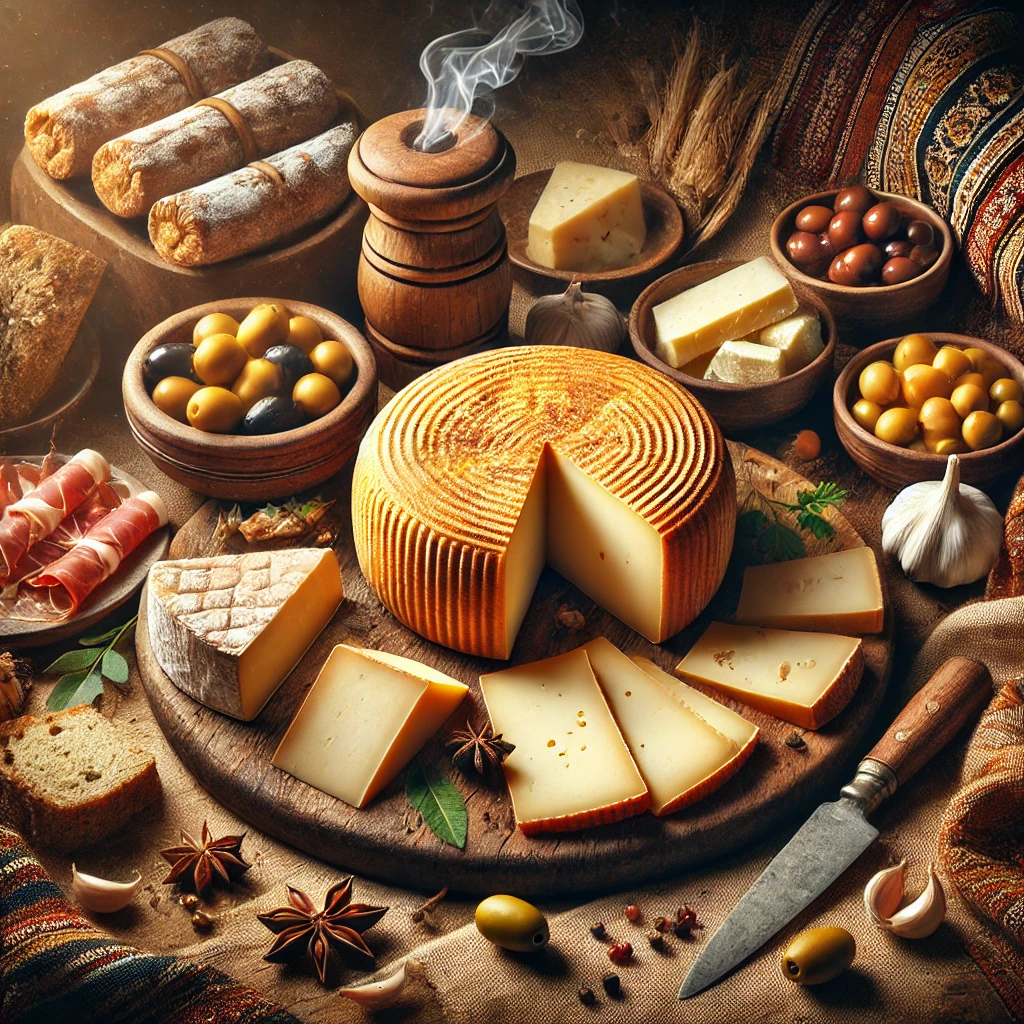Montenegro holds a special position on the Adriatic map—where mountains drop into blue coastal waters, cured meats hang from stone houses, and cheese matures in mountain air perfumed with wood smoke. At the core of this tradition is Njeguški sir, a cheese born in the tiny yet legendary village of Njeguši, near Mount Lovćen. Known for its gentle smoking, firm texture, and pastoral purity, Njeguški sir is not just cheese—it is a cultural emblem of Montenegrin highland cuisine.
Often paired with Njeguški pršut (smoked ham) and village wine, the cheese captures the essence of Montenegro’s climate, altitude, and slow heritage production. For cheese travelers, Njeguški sir is a sensory passport to historic stone cottages, mountain breezes, and protected culinary tradition.
🧀 What is Njeguški Sir?
Njeguški sir is a semi-hard, lightly smoked Montenegrin cheese made from cow’s milk, sheep’s milk, or a blend of the two. Its distinct flavor is shaped by:
-
local milk from free-grazing livestock
-
cold mountain smoking chambers
-
sea air circulation drifting up from the Bay of Kotor
-
aging conditions in thick-walled stone rooms
Key Characteristics
| Feature | Description |
|---|---|
| Texture | semi-hard, sliceable, slightly elastic |
| Smoke Level | mild, natural, wood-infused |
| Flavor | buttery, smoky, nutty, lightly salty |
| Aroma | campfire warmth + highland herbs |
| Color | pale ivory to deeper amber edges |
| Aging | 1–6 months (sometimes longer) |
Njeguški sir is never aggressively smoked—its aroma is subtle and elegant, designed to complement, not overwhelm.
🌄 Mountain Origins: Why Njeguši Matters
The micro-village of Njeguši is more than geography—it is heritage protected by altitude and tradition.
What Makes the Region Ideal
-
cool, dry mountain climate
-
natural airflow from the Adriatic
-
wild herbs and grasses fed to cattle
-
centuries-old smoking chambers
-
stone-room maturation (low humidity)
These conditions create cheese that tastes like landscape: pine smoke, herb meadows, and salted sea wind.
🔥 Smoking & Aging: The Signature Technique
Njeguški sir undergoes gentle cold smoking, a method that preserves texture without melting or drying the cheese.
How It’s Done
-
Fresh cheese wheels are dried in the open air.
-
Cold mountain smoke (usually beech, oak, or endemic herbs) circulates—low heat, slow intensity.
-
Wheels absorb aroma, not fire.
-
Cheese rests in stone chambers to stabilize moisture and salt.
Result
A mellow smoke profile—never bitter or tar-like—wrapped around buttery dairy sweetness.
🧺 Varieties of Njeguški Sir
Montenegro recognizes several variants, depending on milk and aging differences.
| Variety | Milk Source | Flavor Profile | Texture |
|---|---|---|---|
| Cow’s Milk Njeguški Sir | pure cow | mild, creamy, gentle smoke | semi-hard, smooth |
| Sheep’s Milk Njeguški Sir | pure sheep | deeper tang, earthier smoke | firmer, slightly crumbly |
| Mixed Milk Blend | cow + sheep | balanced richness, nutty smoke | elastic but structured |
| Extra-Aged Njeguški | 6–12 months | sharper, salt-crystal finish | dense, grating-friendly |
Sheep-milk versions carry stronger mountain character and historic pastoral identity.
🍽 How to Enjoy Njeguški Sir
Montenegrins don’t overthink cheese—they eat it with what the land provides.
Traditional Serving
-
slices with Njeguški pršut
-
paired with village red wine
-
alongside olives and mountain honey
Bistro & Modern Pairings
| Dish | Why It Works |
|---|---|
| grilled vegetables | sweetness balances smoke |
| rustic bread with olive oil | highlights dairy richness |
| charcuterie board | elevates ham + cheese duo |
| polenta or kačamak | creamy corn + smoky dairy contrast |
As part of a Lovćen breakfast, Njeguški sir is paired with:
-
homemade bread
-
pršut
-
eggs fried in mountain butter
A highland feast.
🌶 Flavor & Texture Breakdown
Flavor Notes
-
campfire smoke whisper, not intensity
-
buttery core with nutty edges
-
delicate saline finish
-
dried herb undertone
Texture Notes
-
sliceable firmness
-
slight elasticity depending on age
-
tender chew without dryness
Not crumbly like feta, not melty like mozzarella—Njeguški sir belongs to the European village-smoked family.
🌍 Global Comparisons
| Cheese | Similarity | Difference |
|---|---|---|
| Scamorza Affumicata (Italy) | mild smoke | Njeguški is drier & mountain-herbed |
| Idiazabal (Spain) | sheep + smoke | Njeguški is softer, less rustic |
| Gouda Smoked | buttery aroma | Njeguški is more natural, less processed smoke |
| Kashkaval | Balkan identity | Njeguški is distinctly smoked, not brined |
Njeguški sir is the Balkan interpretation of controlled smoke aging, rooted in geography rather than industry.
🍷 Beverage Pairing Guide
Best Matches
| Drink | Reason |
|---|---|
| Vranac (Montenegro red wine) | bold fruit meets mild smoke |
| Rakija (plum brandy) | warmth + cheese saltiness alignment |
| Dry white wine | refreshes palate between savory bites |
| Amber beer | malt sweetness supports wood aroma |
Non-Alcoholic Pairings
-
mountain herbal tea
-
fresh pomegranate juice
-
mineral water from Lovćen springs
🌱 Nutrition Overview
Per 100g (approx.):
| Nutrient | Value |
|---|---|
| Protein | high |
| Fat | moderate to high |
| Salt | medium |
| Calcium | strong |
| Smoke Content | natural wood, no artificial additives |
Health in mountainous societies depended on preserved protein—and Njeguški cheese fulfills that role.
🧊 Storage & Care
Keep It At Its Best
-
wrap in breathable cheese paper
-
refrigerate but do not over-seal
-
allow airflow to prevent damp rind
-
serve at room temperature for full aroma
Avoid storing with strong-odor foods; cheese absorbs scent quickly.
⭐ Final Reflection
Njeguški sir is the taste of Montenegro’s altitude—smoke drifting through stone homes, cattle grazing steep meadows, sea winds brushing rugged cliffs. It is tradition preserved through milk, fire, and mountain culture.
Not overly smoked, not heavily salted—just pure dairy uplifted by wood and wind. From national breakfast boards to modern gourmet pairings, Njeguški sir remains true to its village roots while stepping into the global spotlight.
A cheese that whispers Montenegrin heritage, not shouts it.
FAQs — Njeguški Sir
1. Is Njeguški cheese heavily smoked?
No—smoke is mild and wood-based, creating balanced aroma without bitterness.
2. What milk is used traditionally?
Cow, sheep, or a blend, depending on seasonal grazing.
3. How old is Njeguški sir when eaten?
Typically 1–6 months, though extra-aged versions reach 12 months.
4. What makes Njeguši village special?
Its climate, stone aging rooms, Adriatic airflow, and centuries-old smoke craft.
5. How should Njeguški cheese be served?
With pršut, bread, olives, mountain honey, and Montenegrin wine.



